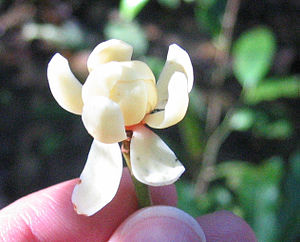Idiospermum australiense
| Idiospermum australiense | ||||||||||||
|---|---|---|---|---|---|---|---|---|---|---|---|---|

Idiospermum australiense |
||||||||||||
| Systematics | ||||||||||||
|
||||||||||||
| Scientific name of the genus | ||||||||||||
| Idiospermum | ||||||||||||
| STBlake | ||||||||||||
| Scientific name of the species | ||||||||||||
| Idiospermum australiense | ||||||||||||
| ( Diels ) STBlake |
Idiospermum australiense is the only plant species of the genus Idiospermum inthe spice shrub family (Calycanthaceae). It is a very pristine tree species endemic to Australia.
features
Idiospermum australiense is an evergreen tree that reaches heights of 20 to 30 m. The nodes are unilacunar with a strand of leaf traces. The opposite, stalked leaves are simple and leathery; they have a smooth leaf margin. The leaves have spherical cells in the mesophyll with essential oils .
The flowers are single or a maximum of three in leaf axils. The flower stalk has several bracts . Most zwittrige (there is a population in the pure male flowers occur) bloom is constructed acyclic, the flower organs are so arranged spirally. The 30 to 40 free bracts change continuously from outside to inside from calyx -like to corolla-like ; they are initially white and later red. While the outer ones fall off, the inner 15-18 remain. Of the 25 to 100 (many) free, flattened stamens , only the outer 13 to 15 are fertile ; especially the staminodes look like bracts. There are one to two (to five) free, upper carpels . The outer integument of the ovule is 12 to 15 cells thick (crassinucellate). The stigma is fleshy and sits almost directly on the ovary. The pollination is done by beetles and thrips that eat (especially their young) pollen and parts of the petals.
The spherical, heavy, poisonous fruit is about 8 cm tall and divides into four segments. The (three to) four cotyledons are well developed and shield-shaped.
Idiospermum australiense has no flavonols , but luteolin does occur. The vessels have step-shaped (scalariform) openings.
Occurrence
Idiospermum australiense is endemic to two small areas in the rainforests of northeast Queensland, Australia. The populations of the two areas differ significantly.
Systematics and botanical history
The species was first described by Ludwig Diels in 1912 as Calycanthus australiensis ( Botanical Yearbooks for Systematics , Volume 48, Page 10).
The next find wasn't until 1971, when the poisonous seeds were the cause of the death of four cows. After the subsequent research, the species was placed in its own genus by Sidney Fay Blake in 1972 ( Contributions from the Queensland Herbarium , Volume 12, page 5). Blake also placed it in its own family Idiospermaceae, but today the species is placed in the family Calycanthaceae , even if it is a bit isolated from the other genera.
Sources and further information
- The genus in the family of Idiospermum Calycanthaceae in APWebsite (Engl.)
- The Idiospermaceae family on DeltaIntKey.
- Australian Plant Name Index.
- Information on the type. (Engl.)
- Entry at GRIN .
Individual evidence
- ↑ Archive link ( Memento of the original from October 7, 2007 in the Internet Archive ) Info: The archive link was inserted automatically and has not yet been checked. Please check the original and archive link according to the instructions and then remove this notice.
- ↑ Archive link ( Memento of the original from October 7, 2007 in the Internet Archive ) Info: The archive link was inserted automatically and has not yet been checked. Please check the original and archive link according to the instructions and then remove this notice.
- ↑ SJWorboys: Polycarpelly in Idiospermum australiense , in Austrobaileya (Vol. 6) (No. 3) 553-556, 2003. Summary: [1] ( Page no longer available , search in web archives ) Info: The link was automatically marked as defective . Please check the link according to the instructions and then remove this notice.
- ↑ Archive link ( Memento of the original from October 8, 2007 in the Internet Archive ) Info: The archive link was inserted automatically and has not yet been checked. Please check the original and archive link according to the instructions and then remove this notice.